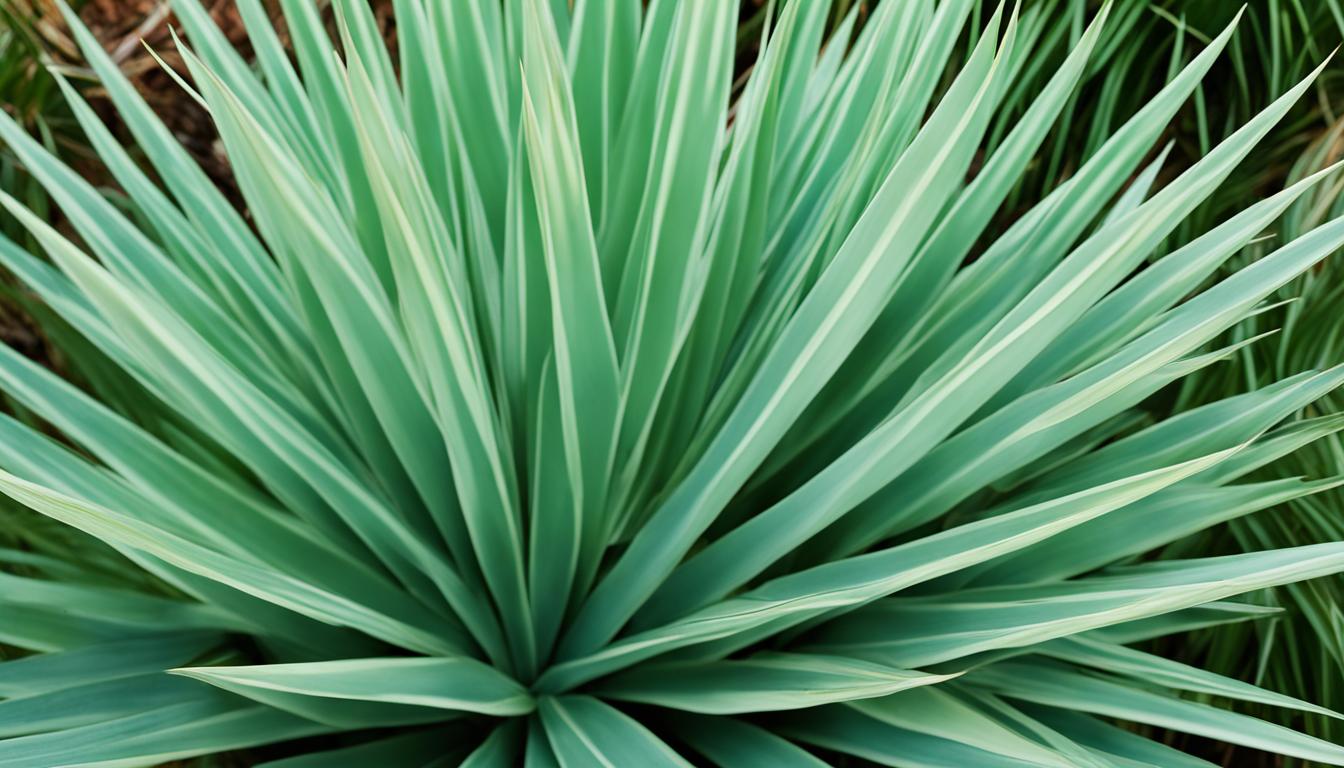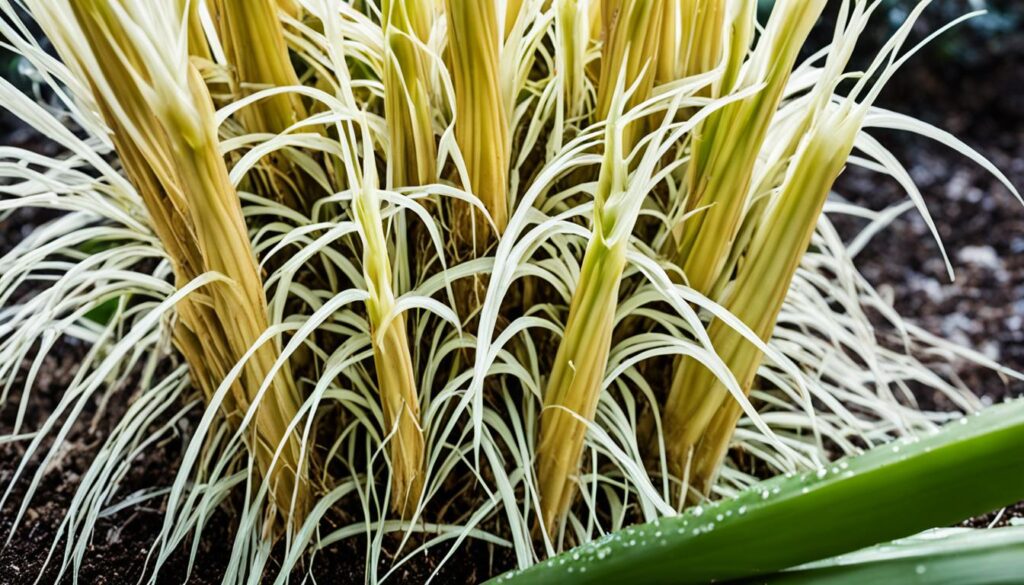Did you know the yucca plant is beautiful and good for indoor air? It’s loved by those living in apartments. This guide covers all you need to know about the yucca. You’ll learn about its growth, care, how to propagate it, and handle pests.
Key Takeaways:
- Discover why the yucca plant is a popular choice for apartment dwellers.
- Learn about its air-purifying properties and pet-friendliness.
- Understand the optimal light, watering, and fertilization requirements.
- Explore potting techniques and propagation methods.
- Find out how to identify and deal with pests and diseases.
Why Do We Love the Yucca Plant For Apartments?
The Yucca plant is loved for many reasons. It looks great and is easy to look after. It’s perfect for bringing a bit of nature inside your home. Let’s look at why so many people like having a Yucca plant.
Is the Yucca Plant Air-Purifying?
The Yucca plant is pretty and cleans the air. It takes away bad stuff from the air. This makes the air in your home better and healthier to breathe.
Is the Yucca Plant Pet Friendly?
Pet owners often worry if plants are safe for their pets. The good news is, the Yucca plant is safe. Although it’s best to keep pets from eating plant leaves, Yucca won’t harm dogs or cats.
How Big Does the Yucca Plant Get?
A Yucca plant doesn’t get too big, which is great for small places. It grows slowly and stays small. But, the size can change based on the type of Yucca and how you care for it.
People love the Yucca plant for its good looks, air cleaning, being safe for pets, and its size. It’s great for anyone starting with plants or who already loves them. A Yucca plant makes any indoor area nicer.
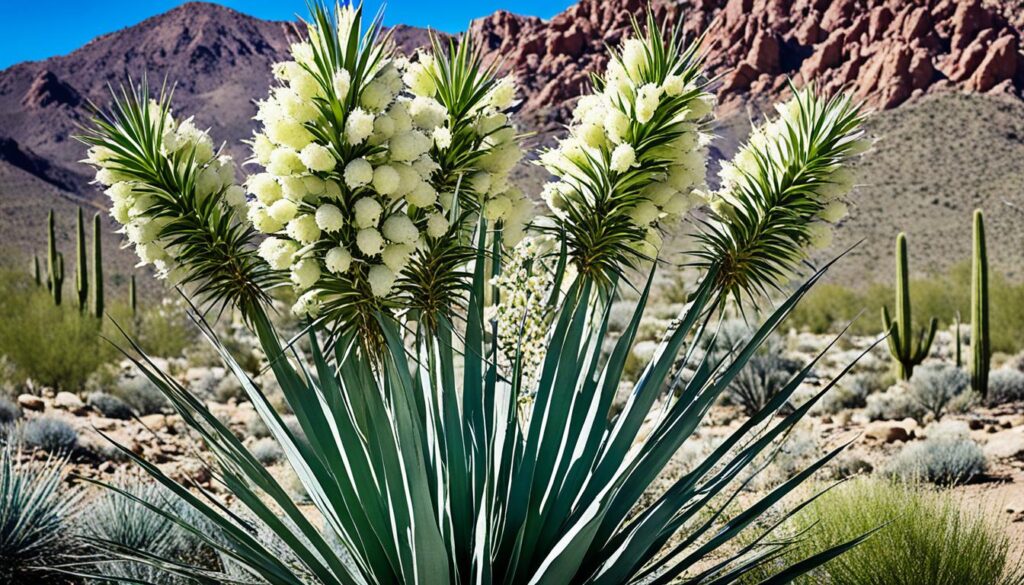
How to Grow a Yucca Plant – Learn to Grow this Indoor Beauty
I’ll show you how to grow a Yucca plant inside. We will pick the right pot and soil. We’ll see how to give it the light, water, and food it needs. We’ll also learn how to keep it looking good. We’ll talk about making new plants and keeping away bugs and sickness. This will help your Yucca plant stay healthy and pretty.
Choosing the Right Pot and Soil
For Yucca plants, the right pot and soil are very important. Choose a pot that lets out extra water to stop root rot. A clay or terracotta pot is best. Use soil that drains well, like a mix of potting soil, sand, and perlite. This mix is just right for the plant.
Providing Adequate Light
Yucca plants love a lot of light. Put your plant near a window that faces south. It needs direct sunlight for at least 6 hours each day. If you don’t have enough sunlight, use grow lights. This will keep your Yucca happy.
Watering and Humidity
Watering your Yucca right is key. Let the top inch of soil dry before watering. Then, give it a good drink. Yucca plants like it drier rather than too wet. Keep humidity around it just right, not too dry or wet.
Nutrition and Fertilization
Yucca plants don’t need much food. Feed them once a month in spring and summer. Use a light, water-soluble fertilizer. Don’t feed them too much. In fall and winter, they rest, so you can stop feeding them.
Pruning and Maintenance
Keep your Yucca plant looking nice with regular pruning. Cut off any yellow or dead leaves. Trim long stems to keep the plant neat. Also, clean the leaves with a damp cloth. This keeps your plant healthy and pretty.
Propagation
You can make more Yucca plants if you want. Use stem cuttings, division, or seeds. Stem cuttings are easy. Just cut a stem and let it root. Division means taking the little plants from the big one. Seeds take longer but are rewarding.
Monitoring for Pests and Diseases
Yucca plants can get bugs and diseases. Check your plant for bugs like spider mites. Also, watch for diseases. Do this often to keep your plant safe. Keeping your Yucca clean and airy helps a lot.
Follow these tips for a happy Yucca plant inside. You’ll see it grow big and beautiful. Enjoy your lovely indoor plant!
Appearance of Yucca Plant
The Yucca plant is a unique and pretty choice for indoors. It has special leaves and flowers. These features make the Yucca plant very interesting to look at.
Foliage
The Yucca plant has cool leaves. They are long, sword-like, and tough. This makes them look neat.
The leaves come in different colors like green or blue-green. Some leaves even have stripes. They grow in a round shape, making the plant look awesome.
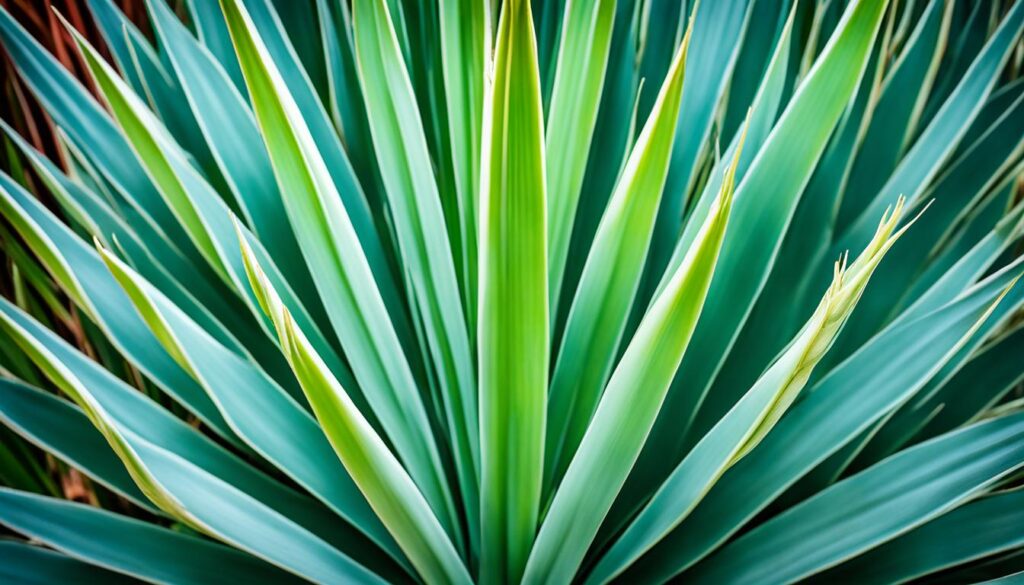
Flowers
Yucca plants have amazing flowers. They grow tall above the leaves.
The flowers are shaped like bells and mostly white. Some can be pink or yellow. They smell nice and bring in bees and butterflies.
Overall Appearance
The Yucca plant is really eye-catching. Its leaves and tall flowers stand out.
It makes any room look more interesting. The Yucca plant is a great pick.
The Yucca plant is truly special. Its leaves and flowers make it look stunning. It’s a great plant for making your space more captivating.
Light Requirements for Yucca Plant
Light is very important for Yucca plants. It helps them grow and stay healthy. We will look at what kind of light Yucca plants need. We will also see how artificial light can help.
Yucca plants need bright, indirect light. A good spot for them is near a window with bright, filtered light. This helps them do photosynthesis and grow well.
Yucca plants can also grow in some shade and less light. If there is less natural light, they grow slower. They might not flower as much either.
If you don’t have enough natural light, you can use artificial lights. LED grow lights are good for Yucca plants. Just keep them far enough away so they don’t get too hot.
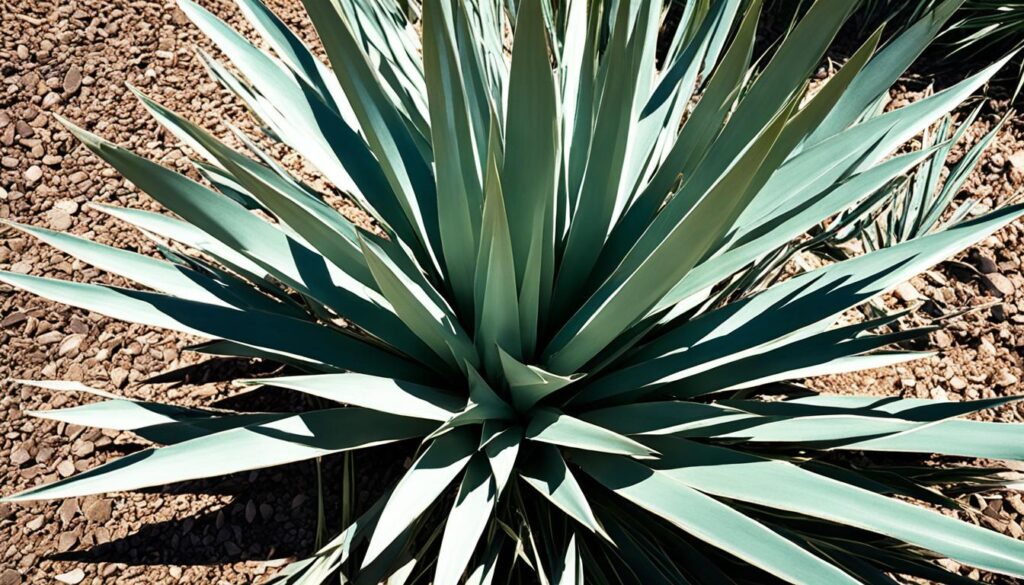
It’s important to mix natural and artificial light right for your Yucca plant. Watch how your plant reacts to light. Change things if needed. If the plant looks weak or the leaves are pale, it might need more light. If the leaves are burnt or yellow, it might need less light.
Getting the light right is key for Yucca plants to grow, develop, and flower. With the right amount of light, your Yucca plants will be beautiful and healthy.
Watering Requirements of The Yucca Plant
Watering your Yucca plant right is key to its health. Knowing how much water it needs will keep it healthy. Give it just enough water to make it grow well inside.
It’s important to water your Yucca just right. Too much or too little water can hurt it. Watch for signs to know if you need to change how much you water it.
Signs of Overwatering vs. Underwatering
Overwatering: Giving your Yucca too much water is easy to do. Look for these signs:
- Yellowing leaves
- Soft and mushy roots or stems
- Foul smell coming from the soil
- Soggy or waterlogged soil
Underwatering: Not giving enough water can stress your Yucca too. Look for these signs:
- Wilting leaves
- Dry and brittle leaves
- Slow growth or stunted development
- Drooping or wrinkled leaves
Watch your Yucca closely for these signs. It helps to water it just right. It’s better to give it less water than too much.
| Watering Recommendations | Indoor Plants |
|---|---|
| Frequency | Every 2-3 weeks |
| Amount | Water thoroughly, allowing the soil to dry out between waterings |
| Watering Method | Direct water at the base of the plant to avoid wetting the foliage |
| Container Drainage | Ensure the pot has drainage holes to prevent water from sitting in the soil |
Use this table as a guide for watering your indoor Yucca. But remember, the exact needs can change based on the pot size, soil type, and your room’s air.
Always keep an eye on your Yucca and change how you water it if needed. With the right water care, your Yucca will grow well and keep looking green.
Fertilizing Yucca Plants
Fertilizing is key to caring for Yucca plants. It helps them grow healthy and bloom. We will look into how to feed your Yucca plants right. We’ll also talk about what kind of food they like best and how to give it to them.
Recommended Fertilizer for Yucca Plants
Picking the right food for Yucca plants matters a lot. A slow-release, balanced food works best. A mix like 10-10-10 or 20-20-20 is usually perfect for them.
Nitrogen (N) keeps leaves and stems growing. Phosphorus (P) helps roots and flowers. potassium (K) keeps the plant healthy and fights off sickness. A balanced mix of these is perfect for Yucca plants.
It’s important to use the right amount. Too much can hurt your plant. Too little and it might not grow right.
Spread the food around the plant’s base. Make sure it doesn’t touch the leaves or stems. Then, water your plant well. This helps the food go deep into the soil.
You should feed your Yucca plant every two to four weeks when it’s warm. Watch how your plant reacts. You may need to feed it more or less often.
Benefits of Proper Fertilization
Feeding your plant right has many perks. It makes your Yucca strong and healthy. It also helps it fight off sickness and bugs. And, it can make your plant bloom beautifully.
By feeding your Yucca regularly with the right stuff, it will look great and be healthy.
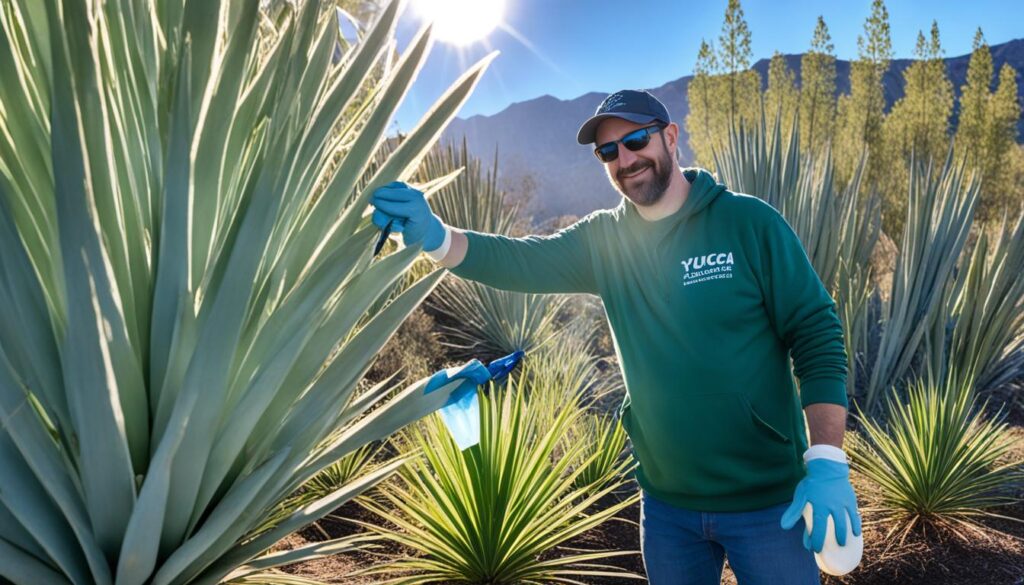
| Fertilizer Dosage | Fertilizing Frequency |
|---|---|
| Follow manufacturer’s instructions | Once every 2 to 4 weeks during the growing season |
Potting Yucca Plants
Proper potting helps Yucca plants grow well. Here’s how to pot them right.
Choosing the Right Pot Size
It’s key to pick a pot that fits. Not too small or too big.
A small pot can stop growth. A big one may cause root rot.
Go for a pot 2-4 inches bigger than the plant’s roots.
Using the Right Potting Mix for Yucca Plants
The potting mix is very important. It needs to drain water well.
Mix potting soil, perlite, and sand equally. This mix is just right.
Repotting When Necessary
Plants can outgrow pots. They might get too crowded.
If roots circle the pot or water drains slow, it’s time to repot.
Do this in spring or summer. These are good times to repot.
Carefully take out the Yucca. Loosen its roots gently.
Put it in a new pot. Fill it up with fresh mix. Water well.
These steps make Yuccas happy. They’ll grow big and beautiful inside your home.
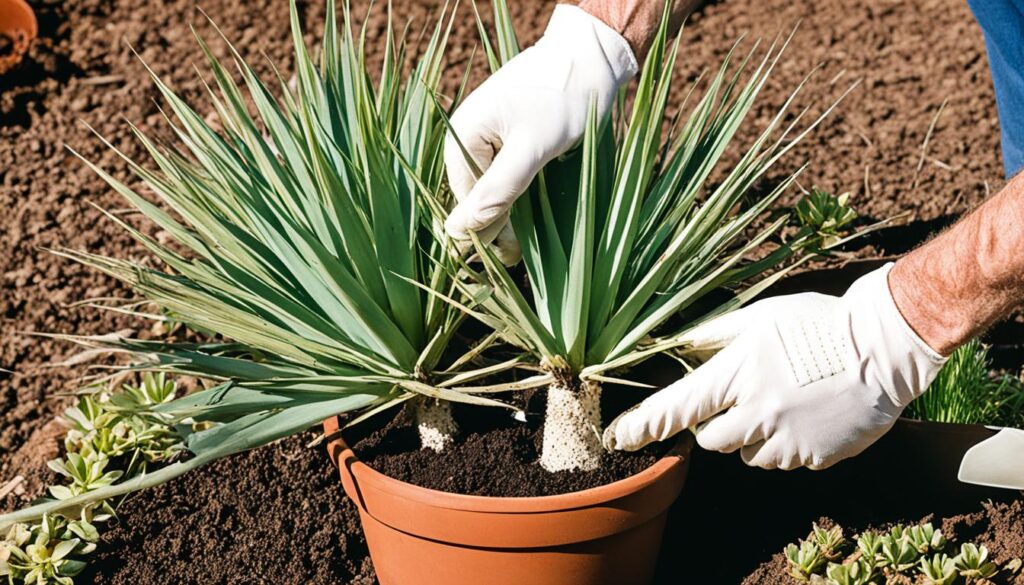
Propagating Yucca Plants
Propagating Yucca plants increases your collection and shares their beauty. You can use stem cuttings or seeds to do this. I will show you how and give tips. I’ll also talk about dividing a Yucca plant.
Stem Cuttings Or Seeds?
To start with stem cuttings, pick a healthy, grown Yucca. Cut a 4-6 inch part of the stem with a clean knife. Remove bottom leaves, leaving some on top. Let the cutting dry for days to avoid rotting. Then plant it in well-draining soil. Keep the soil moist and warm, away from direct sun. With care, it will root and grow new.
For seeds, get ripe ones from mature Yuccas. Plant them in potting mix and cover lightly with soil. Water well and keep the pot warm and bright. It might take weeks or months to see growth. When seedlings have a few leaves, move them to their pots.
Division Of A Yucca Plant
Division is another way to propagate Yucca plants. This means splitting one plant into parts that can grow on their own. First, take the plant out of its pot and gently split the roots. Make sure each part has enough roots and stem. Plant each part in its pot with good soil. Take care of them so they grow well.
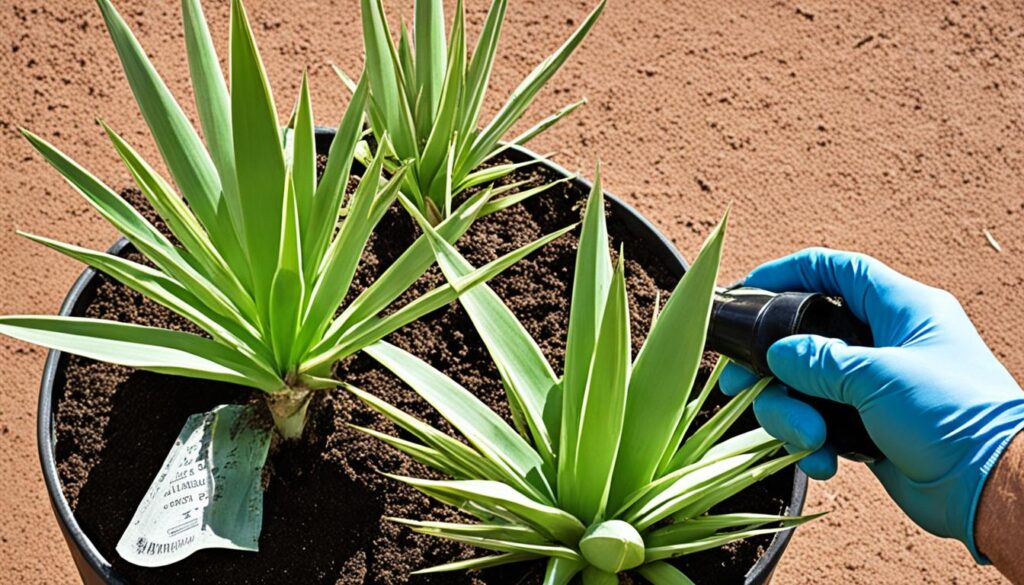
Propagation lets you make more Yucca plants for your indoor garden. You can try stem cuttings, seeds, or dividing. It’s key to give them the care they need to grow. Try these ways and enjoy making new Yuccas.
Growth and Development of Yucca Plants
Understanding Yucca plants’ growth and care is key. I have watched Yucca plants grow from their start to full size.
Yucca plants grow and change over time. Their growth depends on light, water, food, and the environment. With the right care, your Yucca will grow well indoors.
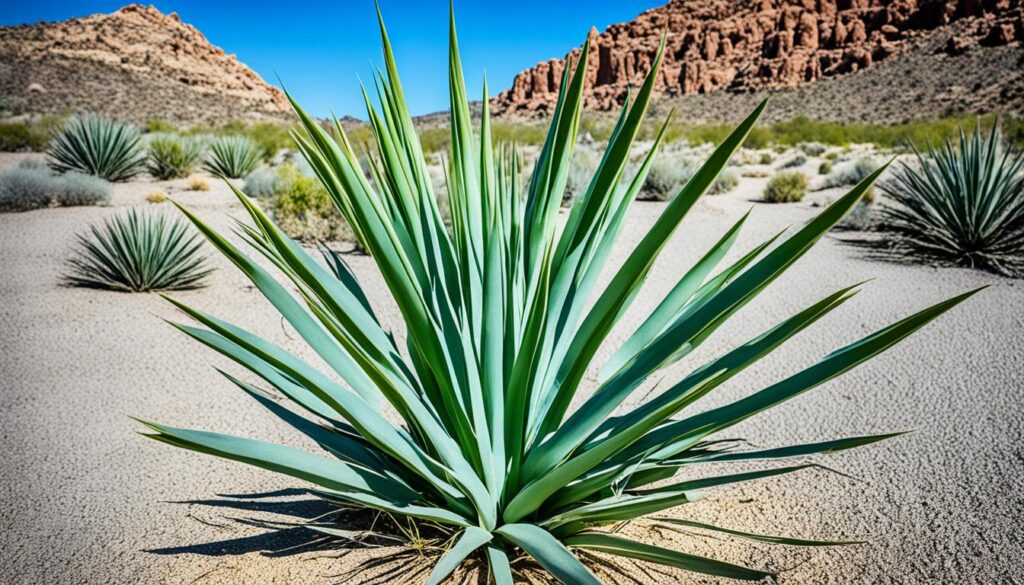
A Yucca plant begins as a small seed or plantlet. With care, it grows roots, leaves, and stems.
When mature, a Yucca’s leaves get big and plentiful, giving it a spiky look.
Flowering is a big event for Yucca plants. Not all flower indoors, but sunlight and good care increase their chances. Yucca flowers enhance any room’s beauty.
It’s important to keep an eye on your Yucca. Watching it helps find and fix problems quickly. Changes in care, like watering more or less sun, can fix issues. Caring for your Yucca at each stage makes it healthy and beautiful.
Dealing with Pests and Diseases in Yucca Plants
Yucca plants can get sick just like us. They can face attacks from bugs and diseases. It’s very important to know the usual problems and how to fix them. Spotting and stopping these issues keeps your Yucca plants healthy and happy.
Common Pests in Yucca Plants
Some bugs love to bother Yucca plants. These include:
- Spider mites
- Mealybugs
- Scale insects
These pests damage the leaves, stems, and roots. Checking your plants often helps catch bugs early. Then you can stop them before they do too much harm.
Controlling Pests in Yucca Plants
There are good ways to fight these pests:
- Natural Remedies: Neem oil or insect soaps can help. They are safe and not bad for the earth.
- Chemical Treatments: Sometimes, you might need stronger stuff. Always ask an expert or read the label carefully.
- Pruning: Cutting away very bug-eaten parts helps keep the rest of the plant safe.
- Isolation: Keep sick plants away from healthy ones to stop bugs from moving.
By doing these things, you can fight off bugs and keep your Yucca plants well.
Disease Prevention in Yucca Plants
Stopping disease before it starts helps a lot. Here’s how to keep your Yucca plants safe:
- Cleanliness: Keep plants clean by removing dead or fallen bits.
- Proper Care: Give your plants enough light, water, and food to keep them strong.
- Avoid Overwatering: Too much water causes rot. Water only when the soil is dry.
- Vigilance: Look for signs of sickness like strange spots or wilted leaves. Catching it early can save your plant.
These steps greatly lower the chance of disease and keep your plants vigorous and healthy.
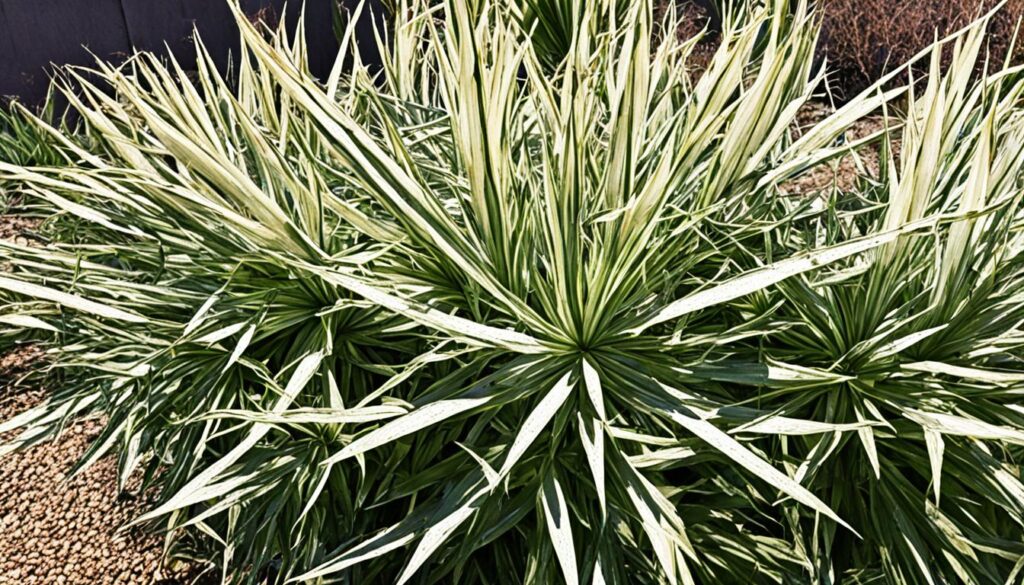
Common Yucca Plant Pests
Yucca plants are lovely indoors. But pests can be a big problem for them. Spider mites, mealybugs, and scale insects are common pests.
Spider mites: These pests are tiny and hard to see. They can turn leaves yellow and slow plant growth.
Mealybugs: Mealybugs look like white cotton on plants. They make leaves yellow and sticky.
Scale insects: They stick to leaves and stems, sucking the sap. This makes plants yellow and weak.
It’s important to spot pests early. Look for yellow leaves or sticky spots. Act fast if you find pests.
Insert the following image:
To fight pests, there are a few things you can do:
- Natural remedies: Use things like insecticidal soap or neem oil. They help get rid of pests.
- Manual removal: Use a soft brush to wipe pests away. Alcohol can help too.
- Isolate infected plants: Keep sick plants away from healthy ones. This stops pests from spreading.
- Chemical treatments: If pests are very bad, chemicals might be needed. But be careful and ask a pro.
Watch your plants closely for pests. Deal with pests right away to keep your plants happy. Good care and quick action can save your Yucca from pests.
Natural Predators
Natural predators help control pests on Yucca plants. This reduces chemical use. Using them creates a healthy environment for your plants. Let’s look at how natural predators help. We will also see how to attract them to your Yucca plants.
Isolate Infected Plants
It’s important to separate sick Yucca plants. This stops pests and diseases from spreading. By doing this, you keep your plants safe. You can also check how bad the infestation is. Then, you can make a good plan to fight the pests.
Chemical Treatment
Sometimes, you might need to use chemicals. This is when natural predators can’t handle the pests. Chemicals should be a last choice. Pick safe chemicals that focus on bad pests but don’t harm good bugs or nature. Always use chemicals carefully and follow the label.
Disease Prevention For Yucca Plants
Keeping your Yucca plants healthy is very important. You can keep them safe from sickness by being careful.
Cleanliness keeps diseases away. Make sure to clean your Yucca plants’ leaves often. This gets rid of dust and bugs that can cause harm.
Taking good care of your plants is crucial. Make sure they get enough light, water, and food. Be careful not to water them too much or too little.
It’s important to give your Yucca plants a good place to grow. They need the right temperature and moisture. Also, don’t put them too close to each other. This helps them stay healthy.
Focus on cleanliness, care, and the right space. This will help your Yucca plants do well and stay free from diseases.
Tips for Maintaining Yucca Plants
Keeping your Yucca plants healthy is important. Follow a few easy tips to keep them looking great.
Wiping Leaves
It’s important to wipe your Yucca’s leaves regularly. Dust blocks sunlight, which plants need to grow. Use a damp cloth to keep leaves dust-free. This helps your plant look good and stay healthy.
Outdoor Exposure
Yucca plants usually live inside, but they like being outdoors too. Put them in a shady spot outside for a bit each day. Choose early morning or late afternoon. Your plant will love the natural light and air. Just introduce it slowly to avoid shock.
Adjusting Watering Schedule
Change how often you water your Yucca with the seasons. Water more in spring and summer, when it’s growing. Water less in fall and winter when the plant rests. Make sure the soil gets a bit dry between waterings. This keeps your Yucca healthy.
Tips for Successful Overwintering of Yucca Plant
Keeping Yucca plants alive in winter is key. Here are some tips to help your indoor Yuccas stay healthy:
- Temperature: Yuccas like it warm, between 60-80°F (15-27°C), when they grow.
In winter, they prefer 45-65°F (7-18°C). Don’t let them get too cold or change temperature quickly. It’s bad for them. - Lighting: Yucca plants need lots of light. In winter, that can be hard.
Put them near a south or west window. Or use grow lights for 12-14 hours a day. This helps them think it’s still summer. - Watering: In winter, Yucca plants sleep and drink less. Let the top soil dry before watering again.
Don’t overdo it. Too much water makes their roots rot. Check the soil and water when needed. - Humidity: Yucca plants don’t need much humidity. But in winter, inside air can dry their leaves.
Put a water tray near them or use a humidifier. This keeps their leaves happy. - Avoid Drafts: Yuccas hate cold drafts. It hurts their leaves.
Keep them away from drafty places and keep their room nice and steady. No sudden cold!
Follow these winter care tips, and your Yucca will be beautiful and strong.
Give them the right warmth, light, and love. Watch them grow happy and healthy.
Growing Yucca Plant from Seed
Growing Yucca plants from seeds is fun and rewarding. You can grow your indoor garden or enjoy seeing Yucca plants start from seeds. I will show you how to grow Yucca plants from seeds. This includes getting seeds ready, germinating them, and caring for young plants.
Seed Collection and Preparation: Get ripe Yucca seeds from big plants. Look for seed pods that are dry and brown. Carefully take the pods off the plant. Let them dry out more. Once they’re dry, open the pods and get the seeds.
Germination Methods: You can germinate Yucca seeds in a few ways. A common way is to soak the seeds in warm water for a day before planting. Or you can scarify the seeds. This means lightly rubbing them with sandpaper to make tiny scratches. It helps water get in and germination happen faster.
Caring for Seedlings: After seeds sprout, they need the right care. Put them in a potting mix that drains well. Keep the soil a bit moist but not too wet. They should be in bright light but not direct sun. Keep them at a warm temperature.
Follow these steps, and you can grow Yucca plants from seeds. Be patient because starting can take weeks or months. It depends on the Yucca type. With good care, you’ll have beautiful Yucca plants that you grew yourself.
Varieties of Yucca Plant
Yucca plants come in many types. Each kind has its own cool things. They are fun for any room. You can find one that fits your style. Yucca plants are not only versatile but also quite easy to care for, making them a great addition to any indoor garden. If you’re looking for something unique, consider pairing your yucca with a mistletoe cactus; just be sure to follow some mistletoe cactus care tips to keep it thriving. With the right attention, these plants can bring a vibrant touch to your living space while ensuring a harmonious blend of textures and colors.
The Yucca elephantipes is also called Spineless Yucca or Giant Yucca. It has long leaves and looks bold. A great plant that grows big.
The Yucca filamentosa, or Adam’s Needle, likes inside places. It has sharp leaves and white flowers. It makes spaces look nice.
The Yucca gloriosa ‘Variegata’ is great for small spots. It has yellow-striped leaves. Perfect for tiny rooms or offices.
FAQ
Q: Is the Yucca Plant Air-Purifying?
A: Yes, the Yucca plant can clean the air. It removes toxins from inside spaces.
Q: Is the Yucca Plant Pet Friendly?
A: The Yucca plant is usually safe for pets. But, stop pets from chewing on plants. If a pet eats part of a Yucca and feels sick, see a vet.
Q: How Big Does the Yucca Plant Get?
A: Yucca plants vary in size. They can grow big, up to several feet tall. Think about this when you pick a spot for your plant.
Q: How to Choose the Right Pot and Soil for Yucca Plant?
A: Pick a pot with holes to stop too much water. Use soil that drains well. Mixing potting soil, sand, and perlite works well for Yuccas.
Q: What are the Light Requirements for Yucca Plant?
A: Yuccas like bright, but not direct, light. Put it by a window with sunlight coming through gently. This stops leaves from getting burnt.
Q: How Often Should I Water the Yucca Plant?
A: Yuccas don’t need a lot of water. Water it well, then let the soil dry before watering again. How often depends on the air around it.
Q: What Type of Fertilizer Should I Use for Yucca Plants?
A: Use balanced fertilizer for indoor plants. Check the label for how much and how often. Feed your Yucca in its growing season for the best growth and flowers.
Q: How to Propagate Yucca Plants?
A: You can grow new Yuccas from stem cuttings or by dividing it. Cut a healthy stem and let it dry before planting. Or, separate the little plants from the main one and replant them.
Q: How to Monitor for Pests and Diseases in Yucca Plants?
A: Check your Yucca for bugs like spider mites and signs of disease. Look out for yellow leaves or spots. Keep the plant healthy by caring for it well.
Q: How to Maintain Yucca Plants?
A: Clean Yucca leaves with a wet cloth to remove dust. Change watering with the seasons. Get your plant used to outside slowly to prevent shock.
Q: How to Overwinter Yucca Plants?
A: In winter, Yuccas rest. Keep them cool and light, between 45-55°F. Cut back on water and food during this time.
Q: How to Grow Yucca Plants from Seeds?
A: To grow Yuccas from seeds, soak the seeds first. Then plant them in draining soil. Keep them warm and damp. With care, they will sprout.
Q: What are Some Popular Varieties of Yucca Plants?
A: Popular Yuccas are Yucca elephantipes, Yucca filamentosa, and Yucca gloriosa. Each one looks different, with unique leaves and flowers.

